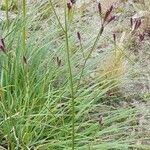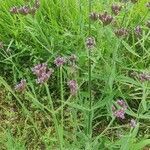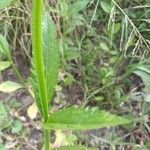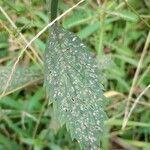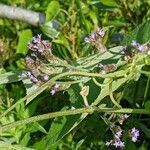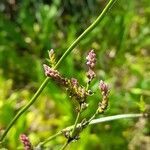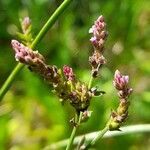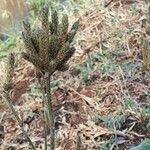Perennial; stems erect, square, scabrid, to 2 m tall. Lvs sessile, 5-7 × 1-1.5 cm (probably much larger on vegetative shoots), lanceolate or elliptic-lanceolate, strigose on both sides with bulbous-based hairs above, coarsely serrate; veins impressed; base ± attenuate with no distinct petiole; apex short-acuminate. Infl. much-branched, composed of spikes; spikes closely packed, 1-5 cm long at maximum flowering, not elongating much at fruiting, fairly stout; rachises scabrid; fls dense. Bracts slightly > calyx, linear to lanceolate, acuminate, hairy, ciliate, keeled. Calyx 2-3 mm long, with appressed hairs; teeth subulate, probably purple. Corolla with scattered hairs outside; tube slightly > calyx; limb 2-3 mm diam., mauve or purple, drying deep blue. Nutlets 1-1.5 mm long, oblong-obovoid, white-papillate on flattened ventral surface, wrinkled on dorsal surface, longitudinally ribbed.
Inflorescences much branched, consisting of numerous spikes in dense flat-topped or rounded clusters, the spikes cymosely arranged and mostly in dense groups of triads, of which the median spike is usually longer and subsessile, and the lateral ones on peduncles up to 12 mm long; spikes densely flowered, 0.5–1 cm long and conical when in flower, 3.5–8(10–12) cm long and 0.3–0.6 cm thick and cylindric when in fruit, sometimes arched; bracts usually equalling or slightly overtopping the calyx, the upper ones distinctly longer than the buds and forming a short tuft at the top of the spike, 2.5–3(3.5–4) mm long and 0.75–1 mm wide at the base, lanceolate, attenuate towards an acute sometimes ± filiform apex, pilose without glandular hairs intermixed, ciliate on the margins.
Perennial herb, 0.5-1.0 m high; suberect, forming wide V with stem, 4-angled, scabrid, hairs tubercle-based, bristles whitish, denser along angles. Leaves lanceolate to ovate-oblong or oblong, 50-80 x 12-35 mm, base semi-amplexicaul, apex acute, margins serrate to double serrate, teeth ± acute. Inflorescence of many cymosely arranged spikes, in dense flat-topped or rounded clusters; bracts lanceolate, apex acute, ± filiform. Flowers mauve, purple or bluish purple. Calyx 20-28 mm long, teeth acute. Corolla: tube exserted above calyx teeth; limb up to 3 mm in diam. Fruit of 1.2-1.7 mm long mericarps, 3-5-ribbed on back, slightly raised-reticulate in upper part. Flowering time Jan.-May?.
Stout annual to 2.5 m, the stem 4-angled, somewhat scabrous-hairy above; lvs elliptic to linear-elliptic or lanceolate, tapering to a subsessile or petiolar base, sharply serrate or incised, at least above the middle, strigillose above, sparsely hairy beneath; spikes compact, mostly short, usually sessile in open cymes, not crowded; bracts scarcely equaling the cal, lance-subulate, ciliate; cal 3–4 mm; cor purple or lilac, its tube a little longer than the cal, hairy outside, the inconspicuous limb 2.5 mm wide; nutlets 1.5–2 mm; 2n=28. Native of S. Amer., intr. in dry sandy soil and waste places from Va. to Fla. and La. Mostly Apr.–Sept.
Leaves (1.4)5–8(12) cm long and 1.2–3.5(4.5) cm wide, oblong or ovate-oblong to lanceolate, acute at the apex, semiamplexicaul at the base, serrate to double serrate on the margin, the teeth ± acute, the base sometimes entire; lamina stiff, scabrid with patent acicular tubercle-based hairs, the indumentum densest beneath particularly on the nervation; midrib and nervation impressed above, raised beneath; the upper leaves smaller and relatively narrower, sometimes linear-lanceolate, sometimes entire.
Annual, occasionally a short-lived perennial, robust herb, 0.7-1.5 m high. Stems stiff, branched above, 4-angled. Leaves simple; blade oblong, ovate-oblong to narrowly ovate, 50-80 x 12-35 mm, decurrent, margins serrate to double serrate. Flowers: in many spikes, spikes in a dense flat-topped or rounded cluster; uppermost corolla limbs not overtopping spike; floral bracts equalling or slightly longer than calyces; corolla tube up to 5.5 mm long, corolla mauve, purple or bluish purple; Sep.-May.
Stem stiff, branched above, 4-angled, with whitish angles and flat faces, up to 7 mm wide at the base, somewhat constricted just below each node, scabrid and sparsely to densely hispid with tubercle-based hairs up to 1.5 mm long, the bristles whitish spreading and denser along the angles; branches 4–9 cm long, suberect or forming a wide V with the stem.
Corolla mauve, purple or bluish-purple, pubescent outside, the uppermost not overtopping the spike except sometimes at the end of flowering; tube (2.5)2.75–3(3.5) mm long, (0)0.5–0.75(1–1.25) mm exserted above the calyx teeth; limb 2.75–3 mm in diameter.
Robust herb, 0.7-1.5 m high. Leaves distinctly petiolate or tapering to cuneate-attenuate base, dentate. Inflorescence scarcely ramified, shorter than 50 mm, very dense and appressed pubescent. Flowers purple.
Mericarps 1.2–1.7 mm long, with 3–5 ribs on the back, and slightly raised-reticulate in the upper part.
Stamens inserted near middle of the corolla tube; anthers 0.25–4 mm long.
Calyx (1.75)2–2.75(3) mm long, with acute teeth, hispidulous outside.
Perennial herb up to c. 2.5 m tall.
Style (0.75)1–1.25 mm long.
